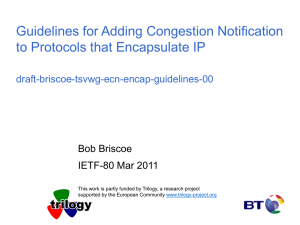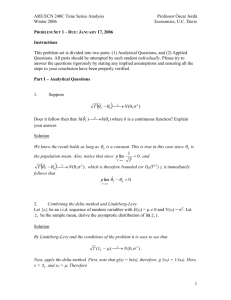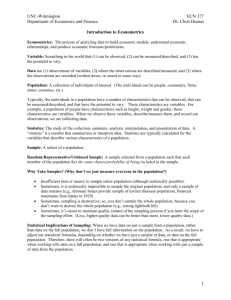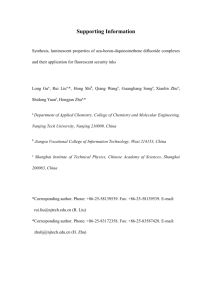Author template for journal articles
advertisement
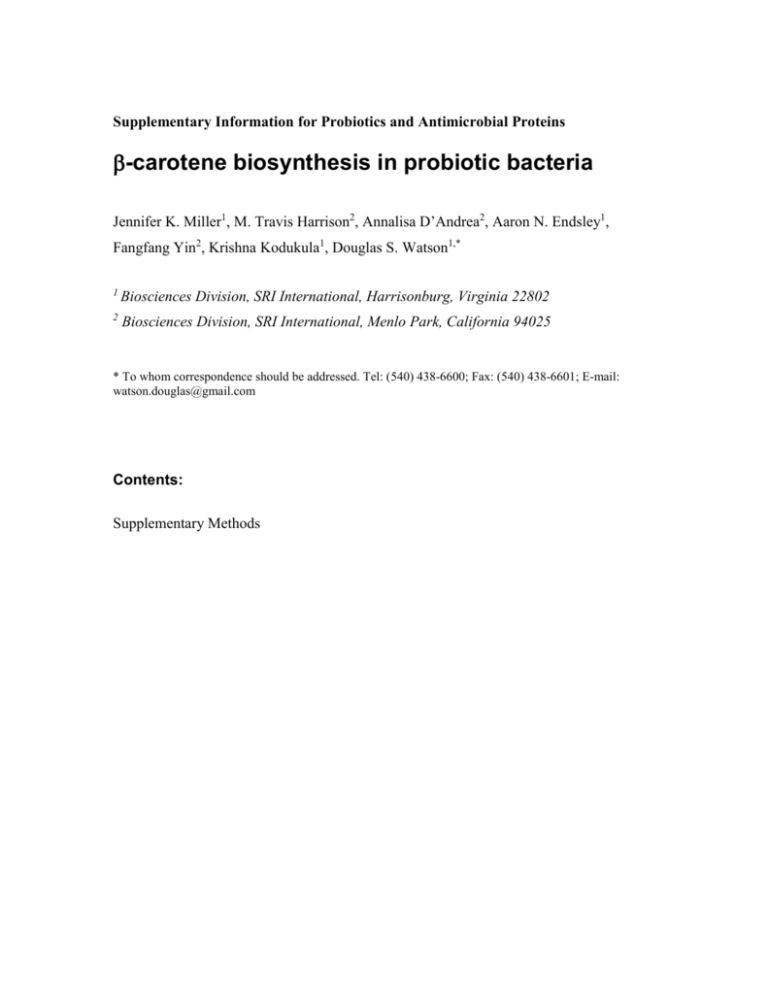
Supplementary Information for Probiotics and Antimicrobial Proteins -carotene biosynthesis in probiotic bacteria Jennifer K. Miller1, M. Travis Harrison2, Annalisa D’Andrea2, Aaron N. Endsley1, Fangfang Yin2, Krishna Kodukula1, Douglas S. Watson1,* 1 Biosciences Division, SRI International, Harrisonburg, Virginia 22802 2 Biosciences Division, SRI International, Menlo Park, California 94025 * To whom correspondence should be addressed. Tel: (540) 438-6600; Fax: (540) 438-6601; E-mail: watson.douglas@gmail.com Contents: Supplementary Methods Miller et al. 2 Methods Generation of EcN-BETA Strain Electrocompetent EcN were prepared as follows. An isolated EcN colony was inoculated into 50 mL lysogeny broth (LB) and grown for 16 h at 37 oC with shaking at 250 rpm (final OD600 4.6). 40 mL of this starter culture was inoculated into 950 mL LB and grown at 37 oC with shaking at 250 rpm until OD600 0.6 was reached. This culture was transferred to an ice water bath, cooled, pourted into ice cold centrifuge bottles, and centrifuged at 2500 rpm for 30 min at 4 oC (RC-5C Plus, Sorvall, Newtown, CT). Supernatants were decanted and pellets were resuspended by pipetting in 500 mL ice cold, sterile double distilled H2O. Centrifugation and resuspension was repeated in 250 mL double distilled H20, followed by 10 mL sterile 10% glycerol. Contents of multiple centrifuge bottles were then combined, centrifuged, and resuspended in 1 mL sterile GYT medium (10% v/v glycerol, 0.125% w/v yeast extract, 0.25% w/v tryptone) with gentle swirling. Aliquots of the cell suspension (50 L) were snap frozen in liquid N2 and stored at -80 oC. EcN was transformed with pSTBlue-BETAipi as described below. Aliquots of electrocompetent EcN, prepared as described above, were thawed on ice. Plasmid (pSTBlue-BETAipi; 200 ng in 5 L) was added to electrocompetent cells and stirred gently with a pipet tip to mix. The contents were transferred to an ice cold electroporation cuvette (2 mm gap) and pulsed at 2 kV, 25 mF, 200 Ω (GenePulser X Cell Electroporator, Bio-Rad, Hercules, CA). Cells were diluted in 950 L SOC medium (Invitrogen) in a 1.5 mL microcentrifuge tube, incubated on ice for 2 min, and further incubated for 3 h at 37 oC with shaking at 200 rpm. This mixture (50 L) was streaked onto LB agar plates containing 100 g/mL carbenicillin (‘selective LB agar plates’) and incubated at 37 oC overnight. Individual transformed colonies were clearly identifiable by an orange color. EcN was transformed with an empty vector plasmid lacking insert (pSTBlue1, Novagen, Madison, WI) by an analogous method to generate a control strain (EcN-VECTOR). To generate glycerol stocks, individual colonies were selected, inoculated into 4 mL LB containing 100 g/mL carbenicillin (‘selective LB’), and incubated overnight at 37 oC with shaking at 250 rpm. This overnight culture was diluted with an equal volume of 50% (v/v) sterile glycerol, aliquotted, and frozen at -80 oC. The identity of the EcN strain and the presence of pSTBlue-BETAipi were confirmed by PCR. Isolated colonies of EcN-BETA, untransformed EcN, E. coli DH5, and E. coli K-12 were inoculated into 5 mL LB (or selective LB, for EcNBETA) and grown 16 h at 37 oC with shaking at 250 rpm. After 16 h, plasmid DNA was isolated using a QIAprep spin Miniprep kit (Qiagen, Valencia, CA) according to the manufacturer’s protocol. For PCR of isolated plasmid, DNA template (50-90 ng) and primers (10 pM) were added to a PCR master mix in thick walled 0.65 mL microcentrifuge tubes and PCR reactions were performed in a PTC-200 Peltier Thermal Cycler (MJ Research, Waltham, MA) using the 2 Miller et al. 3 following program: 94 oC for 2 min, repeat 29x (94 oC for 15 s, 50 oC for 30 s, 68 o C for 30 s), 72 oC for 5 min. DNA polymerase was from Invitrogen (Platinum Taq High Fidelity) and dTNPs were from Takara (Otsu, Shiga, Japan). Following amplification, samples were run on a 1.0% agarose gel at 95 V (Power Pac 300, Bio-Rad), stained with ethidium bromide, and imaged with a Chemi Doc™ XRS+ (Bio-Rad). Primers specific for EcN cryptic plasmid pMUT2 were identical to those reported by Blum-Oehler et al. 1: F1 – 5’GACCAAGCGATAACCGGATG-3’; R1 – 3’-GTGAGATGATGGCCACGATT5’; F2 - 5’-GCGAGGTAACCTCGAACATG-3’; R2 - 3’CGGCGTATCGATAATTCACG-5’. Primers specific for pSTBlue-BETAipi were designed from the insert sequence obtained during this work: F3 - 5’CCTGAGCGATCTAAAGCAGGCTGATA-3’; R3 - 3’GGGCTGACTTCAGGTGCTACATTT-5’. Expected sizes for these PCR fragments were 427, 313, and 427 bp, respectively. Spectrophotometric Assay of -carotene -carotene was detected spectrophotometrically by its characteristic absorption maximum near 460 nm 2. At the conclusion of bacterial growth experiments, cells were harvested by centrifugation for 15 min at 3000 rpm (RT7, Sorvall) and supernatants were removed to clean conical tubes. Tetrahydrofuran (THF; 3 to 5 mL) was added to each cell pellet and pellets were homogenized by vortexing continuously for 2 min. Insoluble material was then pelleted by centrifugation for 15 min at 3000 rpm and supernatants were removed to clean conical tubes. In control experiments, this procedure resulted in extraction of >95% of measurable -carotene from bacterial cell pellets. The absorbance of each sample at 460 nm was then recorded using a DU 640 spectrophotometer (Beckman Instruments, Fullerton, CA). When necessary, bacterial extracts were further diluted in THF to maintain absorbance values in the range of 0.1 to 1.1 absorbance units. Absorbance at 600 nm was also recorded to check for turbidity and the presence of residual insoluble material. As a negative control, -carotene was measured in extracts of untransformed EcN by an analogous method. -carotene concentration was calculated from the appropriate standard curves, obtained by preparing 2-fold dilutions of pure -carotene in THF or in control bacterial extracts. Absorption spectra of -carotene in THF, as well as THF extracts of both EcN and EcNBETA, were obtained using a SpectraMax Plus 384 (Carlsbad, CA). In some experiments, the presence of -carotene in the culture supernatant was measured using selective LB media as a blank. In these studies, absorbance values at 460 nm and 600 nm were measured before and after filtration of the culture media through 0.45 m GHP Acrodisc GF syringe filters (Pall, Port Washington, NY). EcN-BETA cultures were grown in the dark and care was taken throughout the course of these experiments to minimize exposure to light. The presence of -carotene in EcN-BETA was further confirmed by an LCMS/MS method by PharmaOn (Princeton, NJ). In brief, THF extracts of EcNBETA were prepared as described, dried by rotary evaporation, and further dried under high vacuum overnight. Dried samples were solubilized in a mixture of methyl tert-butyl ether and ethanol (1:4) and fractionated with a Shimadzu HPLC 3 Miller et al. 4 system (Columbia, MD) on an analytical C18 column (MAC-MOD HydroBondTM, Chadds Ford, PA) using a water:acetonitrile:methanol gradient containing 1% formic acid (v/v). HPLC eluant was analyzed by tandem mass spectrometry using an AB 4000 Q TRAP (AB Sciex, Foster City, CA) with electrospray ionization in positive mode. For these experiments, THF extracts of EcN-BETA containing at least 75 g -carotene were combined and dried prior to solubilization and LCMS/MS analysis. Stimulation of Murine Dendritic Cells with EcN-BETA Murine dendritic cells were derived from the bone marrow of Balb/c mice (Jackson Laboratories, Bar Harbor, ME). Femurs were harvested, the ends of the bones were removed, and the femurs were flushed with PBS. The resulting cell suspension was passed through a 70 µm strainer (BD Biosciences, San Jose, CA) and erythrocytes were removed by hypotonic lysis in Tris-ammonium chloride buffer (20 mM Tris-HCl, 10 mM NaCl, 3 mM MgCl2, pH 7.5) for 4 min at room temperature. Bone marrow cells were plated in flat-bottom 96 well plates in RPMI-1640 medium (Invitrogen) supplemented with 10% FCS, 2 mM Glutamax, and 50 U/mL penicillin and 50 µg/mL streptomycin sulfate. To induce dendritic cell differentiation, cells were incubated for 5 d with 50 ng/mL IL-4 and 40 ng/mL GM-CSF (PeproTech, Rocky Hill, NJ) at 5% CO2 and 37°C in a humidified incubator. After this period, half of the medium was removed and replaced with medium containing bacterial cell extracts or control compounds at the following concentrations: LPS, 1 g/mL; RA, 1 M; carotene, 1 M; EcN-BETA, 0.4 M -carotene; EcN, 0.4 M -carotene equivalent. BDMCs were then incubated for an additional 2 days and supernatants and cells were collected for cytokine and flow cytometery analysis, respectively. THF extracts were chosen for DC stimulation for several reasons. First, THF extracts are amenable to spectrophotometric determination of βcarotene content, whereas bacterial lysates are either turbid or contain detergents that interfere with spectrophotometric β-carotene determination. This permitted cells to be treated with a defined amount of β-carotene. Second, extraction with THF reduces the chemical complexity of the bacterial extract through removal of components that are insoluble in THF, such as proteins, nucleic acids, carbohydrates, and some lipids. Cytokine concentrations in BMDC culture supernatants were quantified by ELISA according to the protocols provided by the manufacturers. IFN-, IL-1, IL-12, IL-6, TNF-, and KC were measured with a mouse 7-plex Th1/Th2 kit (Meso Scale Discovery, Gaithersburg, MD) using a SECTOR Imager 2400 (Meso Scale Discovery). TGF-, IL-22, and IL-23 were measured with kits from R&D Systems (Minneapolis, MN) using a PowerWave HT 340 plate reader (BioTek Instruments, Winooski, VT). For flow cytometry studies, BMDCs were suspended in PBS with 1% BSA (w/v) and 0.05% sodium azide (w/v) and incubated with mouse IgG (Sigma) for 5 min at 2-8°C before adding 0.2-1 µg of each antibody and further incubating for 30 min at 2-8°C. Antibodies Alexa 488 anti-CD1d, PerCP-eFluor 710 anti-MHC Class II (I-A/I-E), PE-Cy7 anti-CD11c, PE anti-CCR9, and APC anti-CD40, 4 Miller et al. 5 along with appropriate isotype controls, were from eBioscience (San Diego, CA). V450 anti-CD86 antibody and a corresponding isotype control were from BD Biosciences (Franklin Lakes, NJ). Cells were then washed 3 times with PBS with 1% BSA and 0.05% sodium azide and analyzed on an LSR II flow cytometer (BD Biosciences). All animal experiments were conducted under protocols approved by SRI’s Institutional Animal Care and Use Committee in compliance with appropriate regulations and policies regarding the humane treatment of animals. 5

